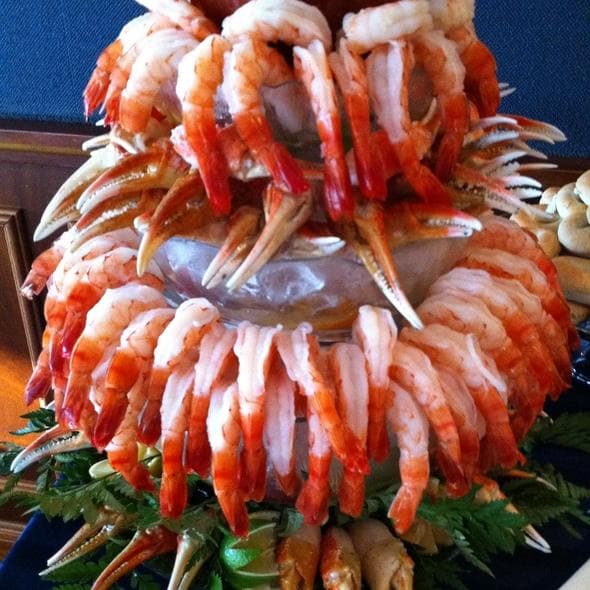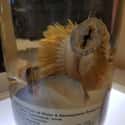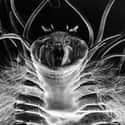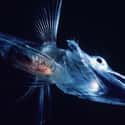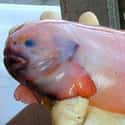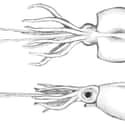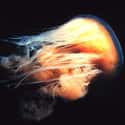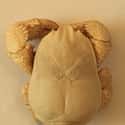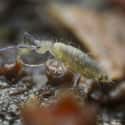-
(#1) Eulagisca Gigantea
This crazy looking marine creature could only survive in two places: your worst nightmare and the Antarctic Ocean. Luckily it's confined to the ocean for now. It also goes by the descriptive title of "bristle worm."
The worm's fringe might seem bizarre, but its bristles help the creature crawl along the ocean floor, swim, and sometimes even defend itself against predators. Because it has sharp teeth, researchers believe the worm is a carnivore, and that it can possibly extend its jaws to catch its prey. To make things even weirder, the part that looks like its head is actually its throat.
-
(#2) Ice Worm
Ice worms are related to leeches and earthworms, and these creepy crawlers are well adapted to life in the cold. They are able to regulate their body temperature so their insides don't freeze. They burrow deep into the surfaces of glaciers and tend to hide there during the day, since they run the risk of dying in warmer temperatures.
If you've ever tried walking on ice, you know it's quite easy to slip. Ice worms, however, transport themselves across and through glaciers by using small bristles on the outside of their bodies to grip the ice and give themselves some traction. And they're pretty good at it too, traveling up to 10 feet per hour across icy surfaces.
-
(#3) Icefish
Icefish are literally some of the coldest-blooded creatures you'll find in the ocean. They'd have to be, if they wanted to survive in the Arctic. Icefish have developed several special features that allow them to thrive in icy waters. Their body temperature is able to adapt to the temperature of the water, and remains very cold. In fact, if they were to encounter higher temperature waters, they would actually die.
Icefish also create glycoproteins, which act as a sort of antifreeze to keep ice crystals from forming on their bodies. But the most unusual thing about these fish is that they lack hemoglobin. The blood of an icefish is white in color, and that, combined with their transparent bodies, allows them to camouflage themselves.
-
(#4) Snailfish
Snailfish are named for their loose, gelatinous skin that takes the place of scales. At the bottom of their tadpole-shaped bodies are giant suckers, which they use to attach themselves to rocks or other objects on the ocean floor. There are about 335 species worldwide, 20 of which make their home in Arctic waters.
They may be somewhat comical, but they have a unique ability: they can live in the deepest parts of the sea, including the Mariana Trench.
-
(#5) Colossal Squid
The creature thought to have inspired the mythical Kraken has rightfully earned a spot on any creepy animal list. It was long thought to be legendary, since the colossal squid is extremely elusive and tends to live at relatively deep depths around Antarctica. In fact, it wasn't discovered to be real until 1925, when giant tentacles were found in the belly of a whale. In 2003, an almost-intact squid was found, and humanity had to wait until 2007 for someone to capture one on video.
One thing that differentiates a colossal squid from a giant squid (aside from the size) is the presence of swiveling hooks inside the suckers on a colossal squid's tentacles. These hooks are apparently pretty nasty too, as many sperm whales have been found with horrible scars, presumably dealt to them by a colossal squid. If the terrifying hooks aren't enough to creep you out, a colossal squid also has the biggest eyes of any creature on Earth.
-
(#6) Tardigrade
- Tardigrada
Tardigrades are one of the most unusual organisms found in Antarctica. They are also known as "water bears" for their plump bodies and clawed limbs, and are thought to be one of the tiniest creatures found on Earth. But anything that can survive in Antarctica shouldn't be judged by its size. In addition to being one of the smallest animals on the planet, they are also one of the oldest.
Tardigrades have the unique ability to remove all water from their bodies and replace it with a sugar, kind of like freeze-drying themselves in order to survive in harsh environments. They were even launched into space to test their tenacity. Most passed the test by surviving cosmic rays, normally deadly levels of UV radiation, and the vacuum of space with flying colors.
-
(#7) Sea spider
- Pantopoda
If spiders creep you out, have no fear. Sea spiders aren't actually spiders and can only be found at the bottom of the ocean. However, for reasons unknown, these arthropods can grow to crazy sizes in locations around the Earth's poles; some have a leg span of up to 10 inches.
They appear to be all legs, and with very little body, they have no need for a respiratory system. While true spiders have eight legs, some of these spiders can have up to 12. They are considered carnivores and dine on sponges, jellyfish, and worms by using a large proboscis to literally suck the life out of their prey like a mosquito.
-
(#8) Lion's mane jellyfish
- Cyanea capillata
The lion's mane jellyfish is the largest of them all; specimens as large as eight feet wide and 120 feet long have been found. It's also possible for them to have up to 1,200 tentacles, making their size seem that much larger. These jellies like to hang out near the surface of the ocean in the Arctic, and have been known to travel in groups.
One lion's mane jelly may have managed to sting more than 50 people who were swimming off the coast of New Hampshire in 2010. After a large number of people suffered stings on the same day, the corpse of a lion's mane jelly was found nearby. Since jellies can sting even after they're dead, it's possible that the deceased 40-pound creature somehow drifted in from colder waters and managed to inflict damage throughout a wide area.
-
(#9) Greenland shark
- Somniosus microcephalus
For a long time, bowhead whales were considered Earth's longest-lived vertebrate animal, with some living to be over 200 years old. But a Greenland shark suddenly became the new record holder as scientists estimated one shark's age at around 400 years. They're also some of the world's largest carnivores and among the most successful predators in Arctic waters.
Unfortunately, those long lives aren't always healthy ones. Worm-like parasites called copepods attach themselves to the shark's eyes and devour them. A Greenland shark may live for many years, but it will likely end up blind.
-
(#10) Hairy Chested Hoff Crab
This crab really is named after David Hasselhoff due to its hairy appearance. This strange hybrid-looking creature was found at a depth of 2,000 meters in Antarctic waters, a spot that is extremely cold.
Hoff crabs survive the low temperatures by hanging out around hydrothermal vents, like campers crowding around the fire to keep warm. But they have to be careful: too close and they'll boil themselves; too far away and they'll freeze. As a bonus, the vents are ideal breeding grounds for the bacteria the crabs eat.
-
(#11) Springtail
- Collembola
Since seals and penguins are only visitors to, and not residents of, Antarctica, the continent's largest creature award goes to an arthropod. There are indeed insect-like organisms in Antarctica, proving there really is nowhere safe from creepy, crawly creatures. Springtails live under rocks along the coast of the continent, and like many other creatures that live in extreme environments, have specially adapted to live in the cold.
Although it is possible for them to freeze to death, springtails use glycerol to keep their bodies safe from temperatures that are too cold. They also have the special ability to slow down their metabolisms to save their bodies from using too much energy, and can go into a hibernation-like state when conditions get too extreme.
The name "springtail" comes from a tail-like protrusion under their abdomen which they use to jump great distances. This unique ability has also given them the nickname "snow fleas."
-
(#12) Grolar Bear
Grolar bears – or pizzly bears, depending on your preference – are not just a Hollywood eco-apocalypse movie idea. In 2016, a hunter near Canada's Hudson Bay shot what he thought was a small polar bear, but realized the creature also had the claws and brown colored paws of a grizzly bear. It is believed that this was actually a hybrid of the two types of bear, and similar sightings have been happening more frequently.
As climate change causes Arctic areas to warm, many grizzly bears are moving north since the frigid temperatures are no longer tempting them to stay away. And since polar bears are now having to travel farther to find food, it was only a matter of time before the two met up and started making babies.
-
(#13) Antarctic krill
- Euphausia superba
Krill are a food source for whales and many other creatures, making them one of the most basic organisms in the Antarctic food chain. They simply float with the ocean currents and are unable to swim against them. They're about the size of a shrimp and feature transparent bodies to help camouflage themselves into their environment.
Krill obtain energy from sunlight and can often be found floating in large swarms near the surface in summer and traveling to deeper and warmer depths in the winter. But since climate change is causing the polar ice to melt, there isn't as much algae for the krill to eat. And if there's not as many krill, other creatures won't have food either, upsetting the entire ecosystem.
-
(#14) Narwhal
- Monodon monoceros
Also called "the unicorn of the ocean," the narwhal is luckily not as elusive as the mythical horse. This unusual looking horned sea creature is the rarest whale in the world. The tusk growing out of its head is actually a giant tooth that grows through the male's upper lip and can measure about eight feet long. Although it is usually the males that grow the tusk, females have been known to grow a smaller one.
Scientists are still baffled about the reason for a narwhal's tusk. They theorize males may use them to impress females, or perhaps to fight over mates, since tusk battles between male narwhals have been observed. It's possible they also use the tusk to help with the capture of prey for food. They live in Arctic coastal regions and are often hunted by Inuit people as a traditional part of their diet.
-
(#15) Walrus
- Odobenus rosmarus
Walruses are definitely odd looking Arctic creatures, but they have some strange habits and abilities that make them even crazier than they look. Their signature tusks are actually teeth, which can grow up to three feet long and can be found on both males and females. Since their bodies are so enormous, walruses use their tusks to dig into the ice as leverage to haul themselves out of the water. They can also be used to fight for mates or dig holes in ice from below.
In order to survive in frigid temperatures, both on land and in the water, walruses can slow down their heartbeat in order to save energy and keep themselves warm. Also, these blubbery animals are equipped with long whiskers which they use to feel around for prey in dark waters.
Although they may appear quite aggressive, no human has ever been harmed by an unprovoked walrus attack. However, humans almost hunted these creatures to extinction, and walrus hunting is now illegal outside of allowances for certain Inuit tribes.
New Random Displays Display All By Ranking
About This Tool
In the extremely cold polar regions of the world, a variety of creatures thrive there with tenacious perseverance. There are the Arctic terns that travel to and from the poles of the earth, the emperor penguins, the beluga whales, and the polar bears that dominate the snow world, and more. These unique animals make the cold areas full of vitality.
Several birds and mammals have experienced long migrations and thrived in the polar regions and survived for generations, they have fully adapted to the harsh polar climate. Here the random tool lists 15 crazy animals in the polar regions that can not be found in any other region.
Our data comes from Ranker, If you want to participate in the ranking of items displayed on this page, please click here.

